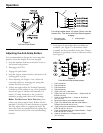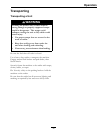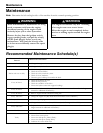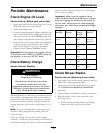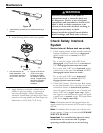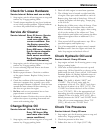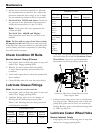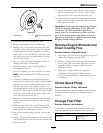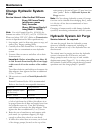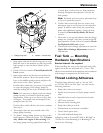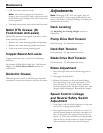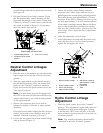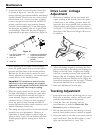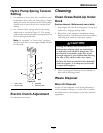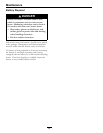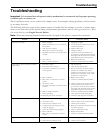
Maintenance
Change Hydraulic System
Filter
Service Interval: After the rst 250 hours
Every 500 hours/Yearly
(whichever comes
rst) thereafter
(Every 250 hours/Yearly if
using Mobil 1 15W50)
Note: Use only Exmark Part No. 109-4180 for
Summer use above 32°F (0°C) or P/N 1-523541 for
Winter use below 32°F (0°C) (Refer to Transmission
section in Specications for lter specications).
1. Stop engine, wait for all moving parts to stop, and
remove key. Engage parking brake.
2. Carefully clean area around lter. It is important
that no dirt or contamination enter hydraulic
system.
3. Unscrew lter to remove and allow oil to drain
from reservoir.
Important: Before reinstalling new lter, ll
it with Exmark Premium Hydro oil and apply
a thin coat of oil on the surface of the rubber
seal.
Turn lter clockwise until rubber seal contacts the
lter adapter, then tighten the lter an additional
2/3 to 3/4 turn.
4. Fill reservoir as stated in Check Hydraulic Oil
Level.
Exmark Premium Hydro Oil is recommended.
Refer to the chart for an acceptable alternative:
Hydro Oil
Change Interval
Exmark Premium Hydro
Oil (Preferred)
500 Hours
Mobil 1 15W50
250 Hours
5. Loosen lter 1/2 turn and allow a small amount
of oil to leak from the oil lter (this allows air to
be purged from the oil lter and supply hose from
the hydraulic reservoir). Turn lter clockwise
until rubber seal contacts the lter adapter. Then
tighten the lter an additional 2/3 to 3/4 turn.
6. Raise the rear of machine up and support with
jack stands (or equivalent support) just high
enough to allow drive wheels to turn freely.
7. If either drive wheel does not rotate, one or both
of the charge pumps (located on the top of the
main pump as shown in Figure 13) may have lost
their “prime”. Refer to Hydraulic System Air
Purge section.
Note: Do Not change hydraulic system oil (except
for what can be drained when changing lter), unless
it is felt the oil has been contaminated or been
extremely hot.
Changing oil unnecessarily could damage hydraulic
system by introducing contaminates into the system.
Hydraulic System Air Purge
Service Interval: As required
Air must be purged from the hydraulic system
when any hydraulic components, including oil
lter, are removed or any of the hydraulic lines are
disconnected.
The critical area for purging air from the hydraulic
system is between the oil reservoir and each
charge pump located on the top of each variable
displacement pump (Figure 13). Air in other parts of
the hydraulic system will be purged through normal
operation once the charge pump is “primed”.
28



